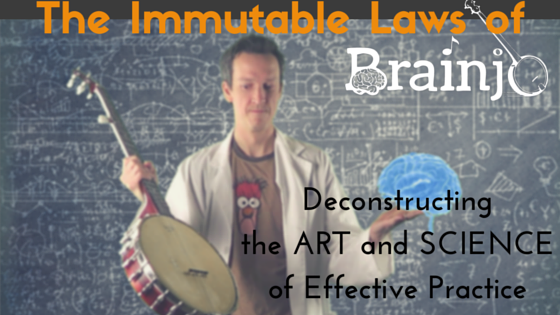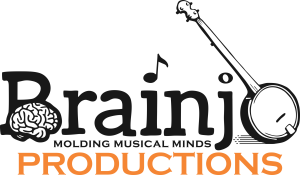Episode 18: How To Accelerate Your Progress 10-Fold (while practicing less!)
In Episode 6, I introduced you to the idea of visualization, an often underrated but immensely valuable technique, as evidenced by its vaunted position in the practice arsenal of elite level performers of all kinds (click here to read the first visualization article).
Beyond being a useful, portable, and cheap practice supplement, it’s also one that supports the creation and reinforcement of those all important sound to motor mappings that are the backbone of musical fluency. These are the brain networks responsible for translating sounds we imagine in our heads to movements of our arms and hands, so that those sounds bounce out of our banjos.
In the early days of learning an instrument learning, so much of the focus is on establishing the technical foundation for playing, all of the right and left hand maneuvers that are required to coax pleasing sounds from the five. And it can be easy to focus on these exclusively for months, even years, until you reach a point where you realize that something is missing.
Here, in part 1 of this episode, I’m going to create a simple and effective way to use visualization to start building those sound to motor (or ear to hand) mappings very early on, potentially shaving months or years off your progression along the timeline of mastery.
Then, in part 2, I’ll share with you another incredible practice method, one that’s been shown to increase learning efficiency 10 fold (and by practicing LESS!)
The basic premise behind these techniques is pretty straightforward: take something you’ve learned, and then visualize yourself doing it. But the specifics of what you focus on will depend in part on where you currently sit on the timeline of mastery.
(RELATED: The “Visualization Library” of tunes has now been added to the Breakthrough Banjo. Click here to learn more about the course.)
Method 1: Visualization for Musical Memory Building (early stage)
For many, remembering learned material, particularly new tunes, is a struggle. I addressed this issue in Episode 15, and there mentioned that ultimately the ability to call forth hundreds of tunes on demand rests upon the creation of musical fluency. But being able to efficiently transfer recalled music to hand movements means that we’re able to remember music in the first place.
As I’ve mentioned previously, you should never attempt to play a tune until you can hum or sing it from start to finish.
Because if you can’t remember how a tune goes, then you’ve got no hope of remembering how to play it. Being able to remember music is essential to musical fluency, yet all too often overlooked in the learning process.
Some folks may remember tunes easily. After hearing it a time or three, they can recall it easily later.
For others, this is not the case at all. If you’re in this boat, then this visualization exercise is for you.
Here’s the technique:
STEP 1 – Each time you hear a new tune you’d like to play some day, write down the title. You can use anything, but a note card works great (and then store the card in a box). If you struggle with remembering music, you might start with songs only (as opposed to instrumentals) at first.
STEP 2 – When writing the tune for the first time, make sure you can hum or sing the BASIC melody from start to finish (NOT a banjo version of the song or tune, but the basic melodic contour; if it’s a song, then you’re remembering how the words are sung). Ideally, have the “answer” available in some form (such as a recording of the actual tune in a playlist in iTunes, spotify, or your preferred music player, or a recording of you humming it, etc.).
STEP 3 – Periodically, test yourself by grabbing a card from your box, and trying to hum or sing the basic melody.
Method 2: Visualization for Building Early Sound to Motor Maps (early to intermediate stage)
If you aren’t one who struggles to remember melodies, then you might wish to jump straight to this visualization technique.
With this one, we’ll start building those all important connections between the sounds in your head and the positions of your hand on the banjo. Remember, these are the networks that are the foundation for jamming, picking out tunes on the fly, improvisation…all the things you associate with musicians at the highest level.
And, as I mentioned earlier, this type of visualization is a way for you to start creating these networks very early on.
Here’s the technique:
STEP 1 – Each time you learn a new tune on the banjo, write down the title. Again, you can use anything, but note cards work great.
STEP 2 – When writing it down for the first time, make sure you can PLAY just the basic melody on your banjo (minus all the banjoistic decorations) in whatever tuning you use for the tune. Ideally, create an “answer” in some form, either a tab of just the melody, or record yourself just playing the melody on the banjo.
STEP 3 – Periodically, test yourself by grabbing a card from your box, and then visualizing yourself playing through just the basic melody on the banjo.
So, as an example, here’s what the basic melody of Cripple Creek (key of A) sounds like: Cripple Creek Melody.mp3
And here’s the tab for that basic melody, played out of standard A tuning (aEAC#E, aka standard G with capo at 2nd fret):

Once again, the idea is to “hear” the melody in your mind as you imagine yourself (first person perspective) playing through it on the banjo.
Over time, your brain will start building the all important associations between the sounds you imagine in your head and the movements of your hands.
Not only will these techniques accelerate your progression along the timeline of mastery, they’re also a great way to keep track of your growing repertoire and take stock of your progress.
In part 2 we’re going to dive into a bit more advanced visualization protocol, along with a memory trick to combine with it that’s been shown to increase learning efficiency 10 fold.
Part 2 is now available! Click here to read it.
Back to the “Laws of Brainjo” Table of Contents

